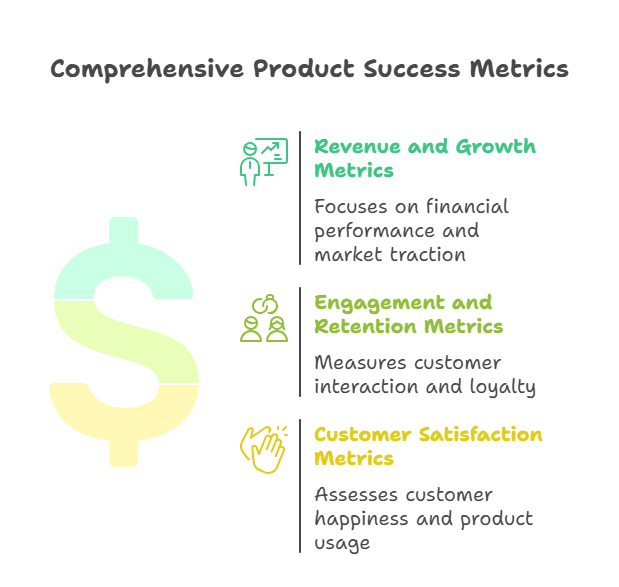How to Analyze Product Success Metrics: A Practical Guide
Learn how to analyze product success metrics effectively. Discover key metrics, frameworks, and tools to measure product performance and drive data-driven decisions.
Why Product Success Metrics Matter
Product success metrics provide measurable, objective insight into customer behavior and help product managers ask questions and find answers. According to The CPO Club, these metrics serve three critical purposes: helping forecast revenue and build business cases, tracking product performance post-launch, and analyzing customer satisfaction.
Effective metrics provide an early warning signal when aspects of your product or user experience aren't working for customers. They also set the stage for success by fueling data-driven decisions that enable product teams to build better products and achieve successful business outcomes.
Key Product Success Metrics to Track

Revenue and Growth Metrics
These metrics help you understand your product's financial performance and market traction:
- Customer Acquisition Cost (CAC): This product management metric indicates the cost of attracting a new customer
- Conversion Rate: This product success metric gives you an idea of how often you're turning visitors into customers
- Monthly Recurring Revenue (MRR): Tracks predictable revenue streams for subscription-based products
- Average Revenue Per User (ARPU): Measures revenue generation efficiency per customer
Engagement and Retention Metrics
Understanding how customers interact with your product is crucial for long-term success:
- Churn Rate: A product management metric that gives you a glimpse into customer retention
- Customer Retention: Another key driver for product success that indicates satisfied customers becoming loyal users
- Daily/Monthly Active Users (DAU/MAU): Measures user stickiness and product engagement
- Customer Engagement Score (CES): Another key product success metric that quantifies user interaction levels
Customer Satisfaction Metrics
These metrics help you understand how customers feel about your product:
- Net Promoter Score (NPS): This customer success metric is measured by looking at the percentage of customers who are promoting your products versus the percentage detracting from your product
- Customer Satisfaction (CSAT): Direct measurement of customer happiness with your product or service
- Product Usage Analytics: Helps you analyze in-app user activities to check whether customers are using your product successfully
How to Analyze Product Metrics Effectively
Identify Your "Metric That Matters"
According to Sequoia Capital, the first step is identifying the one key "metric that matters" for your specific product and business context. This primary metric should align directly with your core business objectives and provide the clearest indication of whether your product is succeeding.
Product metrics should be much more closely linked to business goals than generic metrics like revenue or daily active users. Your chosen metric should reflect the specific value your product delivers to customers.
Establish Baselines and Targets
Before you can analyze trends, you need to establish baseline measurements and set realistic targets:
- Historical Comparison: Compare current performance against previous periods
- Industry Benchmarks: Contextualize your metrics against industry standards
- Goal Setting: Define what success looks like with specific, measurable targets
- Threshold Identification: Determine warning levels that trigger investigation
Use the Right Tools and Frameworks
Effective metric analysis requires the right tools and systematic approaches:
- Segmentation Analysis: Break down metrics by user cohorts, demographics, or behavior patterns
- Trend Analysis: Identify patterns over time to understand seasonal variations and long-term trajectories
- Correlation Analysis: Explore relationships between different metrics to uncover causal factors
- Funnel Analysis: Track user progression through key conversion paths
Creating Your Product Metrics Framework
Start Early and Iterate
It's a good practice to begin discussing success metrics as early as possible during product development, well before the product reaches customers. This ensures you're building measurement capabilities from the start rather than retrofitting them later.
Balance Leading and Lagging Indicators
A robust metrics framework includes both leading indicators (predictive metrics that signal future performance) and lagging indicators (outcome metrics that confirm past performance). This balance helps you both predict and verify product success.
Visualize Your Metrics Strategy
Creating a visual representation of your metrics framework can help your team understand relationships and priorities. ClipMind offers powerful mind mapping tools to organize and visualize your product metrics strategy.
Common Analysis Pitfalls to Avoid
Vanity Metrics Trap
Avoid focusing on metrics that look impressive but don't drive business decisions. Instead, prioritize actionable metrics that directly inform product improvements and strategic choices.
Analysis Paralysis
With numerous metrics available, it's easy to become overwhelmed. Focus on the key metrics that matter most to your specific product goals and avoid tracking everything just because you can.
Ignoring Context
Metrics without context are meaningless. Always consider external factors, seasonality, market conditions, and product changes when interpreting your metrics data.
Turning Analysis into Action
The ultimate goal of analyzing product success metrics is to drive better decisions and improvements. Use your insights to:
- Prioritize product development based on what metrics reveal about user needs
- Optimize user experiences by addressing pain points identified through engagement data
- Allocate resources effectively by focusing on high-impact areas
- Communicate product value to stakeholders using concrete, data-backed evidence
By systematically analyzing the right product success metrics, you can transform raw data into actionable insights that drive product growth and customer satisfaction.
 ClipMind
ClipMind